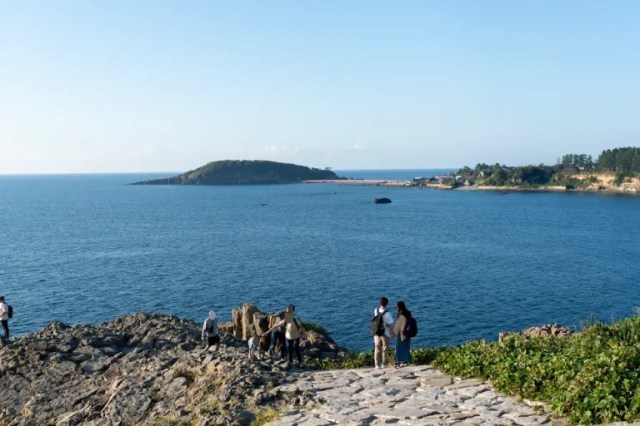
Dramatic coastline has a dramatic reason for sharing its name with a priest from the Heian period.
You’ll find most of Japan’s major cities on or near the southern cost of the country’s main island of Honshu. That’s because the shoreline along the northern coast, which borders the sea of Japan, is decidedly rockier, with fewer gentle bays and more steep cliffs…and the cliffs don’t get much steeper than at Tojinbo in Fukui Prefecture.
Tojinbo has a modest harbor that’s a five-minute bus ride from Mikuniminato Station, with some tourist facilities like restaurants, souvenir shops, and boat tours. As for what those boats take travelers to see, once they leave port it’s not far to the ruggedly beautiful cliffs, where gigantic columnar geological joint formations created by magma combining with sedimentary rock give the scenery an especially dramatic look.
In addition to the cruises, there are also walking paths that wind around the cliffs, which stretch for about a kilometer (0.6 miles) in length. They reach heights of up to 30 meters (98.4 feet) from where it’s a straight drop down into the water, however, so you’ll definitely want to watch your step.
Aside from the striking scenery, there’s an odd linguistic quirk to Tojinbo, which is written in Japanese as 東尋坊. That last kanji character, bo/坊, means “monk” or “priest,” and Tojinbo the place actually gets its name from Tojinbo a Shinto priest who lived in Echizen Province (as northern Fukui Prefecture used to be called) back in the Heian period (794-1185).
Tojinbo, legends say, was not a very popular guy. There are various stories as to how he rubbed people the wrong way, but according to our guide from Japan Railways Group who was showing us around the area, Tojinbo was prone to acts of violence, which is a pretty easy way to earn the ire of your coworkers. Eventually, the other priests of Heisenji Hakusan Shrine decided they’d had enough of Tojinbo’s rage-fueled escapades, and decided to do something about it.
Even before the area took on Tojinbo’s name, the seaside cliffs were a popular sightseeing attraction, and so Tojinbo’s fellow priests proposed going there for a party, so that they could knock back some drinks while admiring the view. This apparently sounded like a swell idea to Tojinbo, who proceeded to get liquored up and was most likely having a great time…right up until the other priests revealed their true reason for organizing the party by grabbing Tojinbo and throwing him off the cliffs into the sea, where he died. Some say his spirit still haunts the shoreline, with folktales holding that when the seas become rough, it’s Tojinbo’s undying rage that’s causing it.
Heisenji Hakusan Shrine, by the way, is a beautiful place in its own right, and of historical significance too, having been founded some 1,300 years ago, so we decided to go check it out.
The deep mossy fields surrounding the main shrine hall have an enchantingly soothing color, and the wooden torii gate’s unique intricate design left a deep impression on us as well.
Though Tojinbo’s home is no longer standing, there’s a marker showing where his personal living quarters used to be…
▼ 東尋坊 = Tojinbo
…and the main hall features some very cool woodworking.
However, we couldn’t help noticing something very unexpected after we’d confirmed where Tojinbo had lived. Since he was lured to a drinking party at the cliffs, we’d just sort of assumed that Heisenji Hakusan Shrine would be very close to the shore, but that wasn’t the case at all. It turns out that the distance from the shrine to the cliffs is 48 kilometers (29.8 miles)! And keep in mind that while we made the trip by car, the priests would have had to walk all the way to the site of their drinking/murder party, which, according to Google Maps, would take 11 hours.
And that’s with modern, paved roads to walk along. Considering they made the trip 1,000 years or so ago, it’s a safe bet that the on-foot journey was even more time-consuming for the priests, probably requiring an overnight stay along the way, which really speaks to just how badly they wanted Tojinbo gone.
Related: Fuku Prefecture official tourism website, Heisenji Hakusan Shrine official website
Photos ©SoraNews24
● Want to hear about SoraNews24’s latest articles as soon as they’re published? Follow us on Facebook and Twitter!
[ Read in Japanese ]